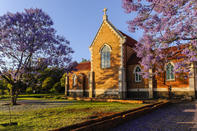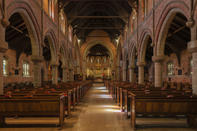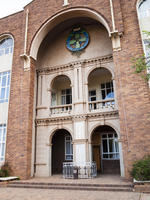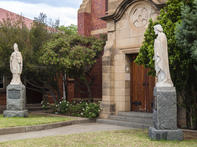Influenced by English Public Schools
St Patrick's Christian Brothers' College (C.B.C.), the first such institution of higher education established by the congregation of the Christian Brothers in this country, is a microcosm of the Catholic Church's mission in the field of education in South Africa.

The school stands a little apart from most of the other historic schools of South Africa, the development of which was influenced to a marked degree by the English public-school tradition. This influence, although not entirely absent in the Christian Brothers' institutions, has been diluted by the strong religious and cultural influences of Ireland.
The Irish arm of the Christian Brothers congregation was founded in 1802 by Edmund Ignatius Rice. The son of well-to-do parents, he was born in County Kilkenny in 1762. He prospered in business and before he was 40 had become a wealthy man. Appalled by the poverty and privation he saw around him, he sold his house and business in 1802 and started a school for the poor and disadvantaged youths of the city. Other men, motivated by his example, followed suit and soon a number of similar schools had sprung up in other counties in Ireland.
In 1822, Rice received formal recognition from the Pope of the Christian Brothers Congregation. Very soon Rome was receiving requests from all parts of the world for the aid of Christian Brother educationists, but a dearth of Brothers meant that a large number of these had to be refused. Nonetheless, the first school outside of Ireland was established in England in 1825, and soon others followed, in Australia in 1868, in New Zealand and Canada in 1876, in India in 1890 and, nearly a century after the founding of the Congregation, in South Africa.
Diamonds Make Kimberley a Well-Established Town

Diamonds were discovered in the northern Cape in the late 1860s and by the end of the 19th century the boisterous mining camp that had grown up around the diamond pipes, Kimberley, was a well-established town.
Linked by rail to Cape Town in 1885 and to its lusty counterpart, Johannesburg, in September 1892, it was no longer one of the Empire's most remote outposts. The wealth and technology generated by the mining allowed Kimberley to become, in its heyday, one of the most modern towns in the world, and the first in South Africa to have electric lights and a tramway.
The diamond industry had been organised, rationalised and stabilised with the consolidation of a myriad small companies into a few great corporations, most dominant among them Cecil John Rhodes's De Beers Consolidated Mines Ltd, and the London and South Africa Exploration Company. The educational needs of the white population of Kimberley - numbered at around 30 000 at that time - had been attended to, with a few schools established, including Kimberley High School, which had an enrolment of more than 200 boys.
However, among the settler population of the mining town were several thousand Irish expatriates, nearly all of them practicing Catholics. While a Catholic diocese had been established, with the dynamic and popular Right Reverend Anthony Gaughren as its bishop, and a cathedral built, there was no Catholic school.
Proposing a Catholic Boys' School

In February 1896 the Bishop called a meeting of the diocese to put forward the proposal to establish a Catholic boys' school. There was unanimous support for the idea, with the resolution being adopted 'that this meeting affirms the desirability of having a high class Catholic boys' school established in Kimberley, and that a committee be formed for the purpose of ascertaining the probable cost of founding such a school and parishioners willing to guarantee towards this project.' (School magazine.)
There followed a frenzy of bazaars, socials, concerts, whist drives, collections and contributions, culminating in the donation by the London and South Africa Exploration Company of a three-acre site for the new school. Nowadays, with complicated financing, computerised accounting and labyrinthian bureaucratic procedures, from this stage to the materialisation of the project would take years - but Victorians were not constrained by such modern niceties and within 18 months plans had been drawn, the thornbush cleared and the building constructed.
Meanwhile, the Bishop had been in contact with the headquarters of Christian Brothers in Dublin, with the result that soon three Brothers - Jarlath Mullan, Malachy Conlon and Evangelist Delaney - were on their way from their lush green homeland to the stark aridity of the Northern Cape, where they arrived in August 1897.
The school opened on 8 September 1897 with 15 pupils under Brother Mullan as first principal. It is a tradition of the Christian Brothers Congregation that a principal of any of its schools serves for three or six years, after which he must stand down, although he may be reinstated for another term after a three-year break.
In the interim he reverts to being an ordinary teacher, either at the same school or at another college. The only exception to this at C.B.C. was in the case of Brother Conlon, who served as principal for one nine-year term, from 1903 to 1912.
Building MacManus Hall

Brother Conlon was succeeded by Brother McCann, who filled the position from 1912 to 1918. Brother O'Sullivan then stepped into the breach, from 1918 to 1921, and he was followed by perhaps the most remarkable of all of C.B.C.'s headmasters, Brother FC McManus. McManus was to serve the school for 50 years, 24 of them spread over four terms as headmaster.
In the 1960s MacManus Hall, dedicated to the memory of this outstanding principal, was built on the front ground facing on to the main thoroughfare of the school.
The original school comprised one large classroom, partitioned off at one end to form a separate room for the senior boys, who were taught by Brother Conlon. The rest of the school was taught by Brothers Mullan and Delaney. In spite of a marked lack of equipment, overcrowding and sometimes harsh discipline, by all accounts the boys enjoyed their schooldays and liked their masters.